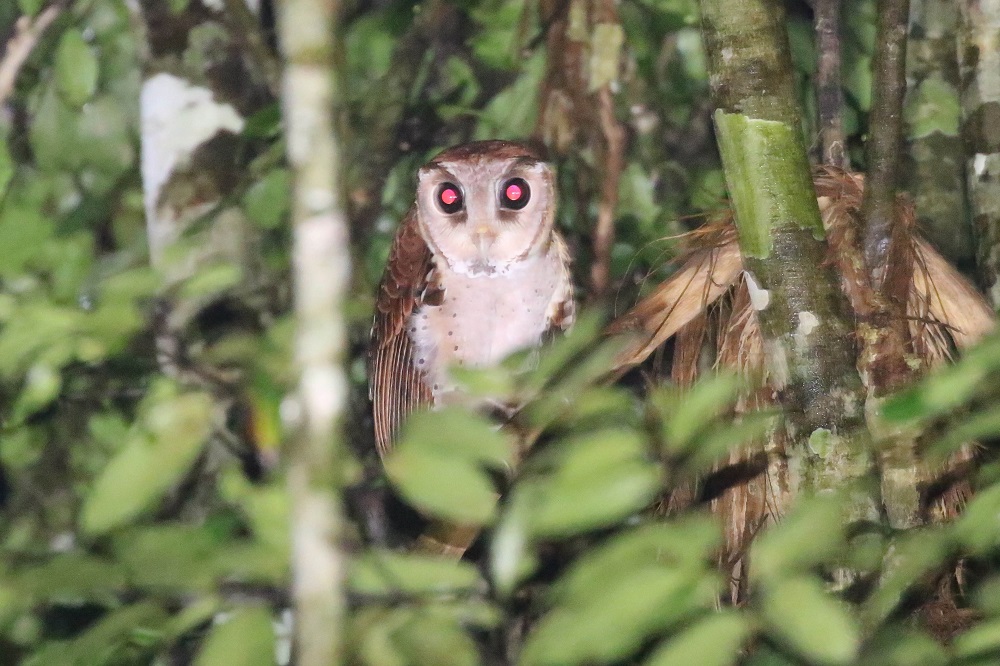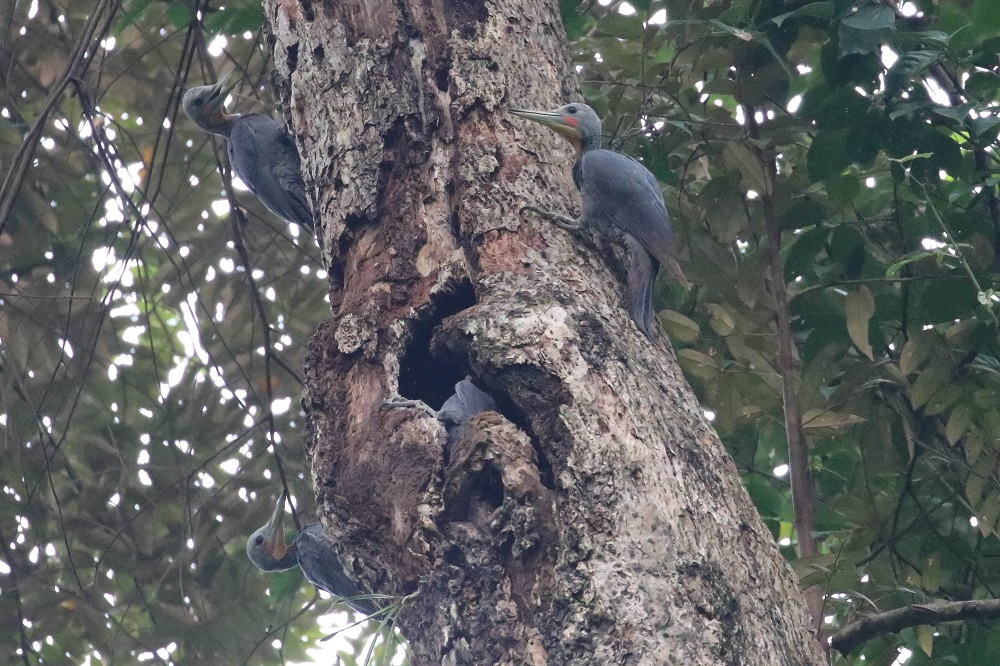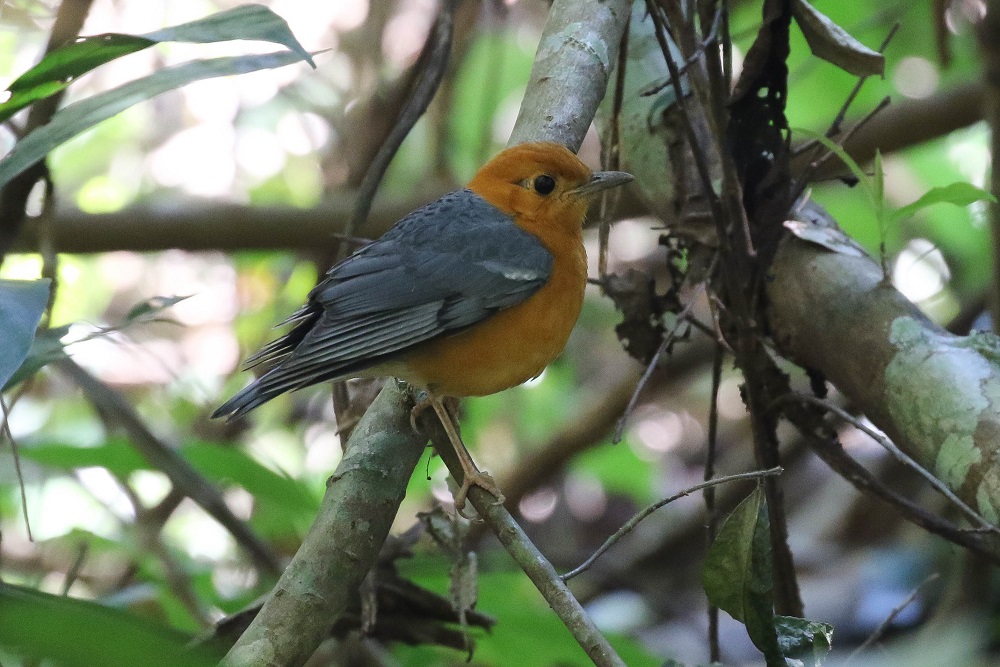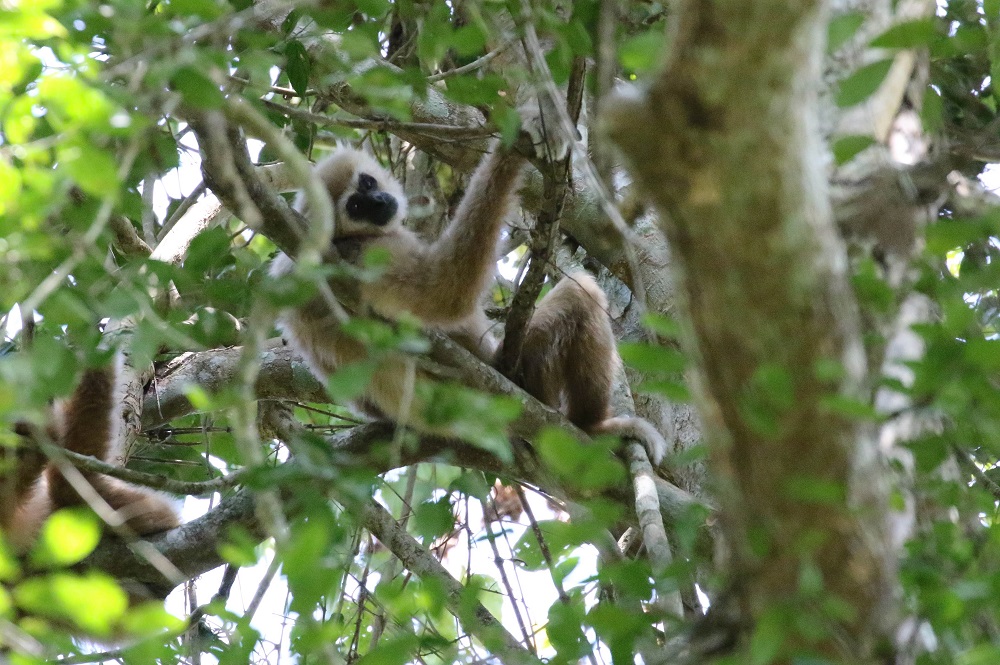January 31 - February 7
8 February 2016 · Arjan Dwarshuis · 7041 × bekeken
January 31st SPOONIES!
After a long flight from Dibrugarh via Dimapur and Kokate - with a 9 hour layover - we finally arrived in Bangkok at 4 'o'clock in the morning. Perfect timing since just 2 hours later we arrived at the crack of dawn at wader-hotspot Pak Thale. Immediately we began to sort through flocks of Red-necked stints, Sanderlings, Mongolian- and Kentish Plovers. We picked out many Great Knots, a couple of Red-necked Phalaropes and a lone Far-Eastern Curlew among the far more numerous orientalis Eurasian Curlews, but after an hour or so still none of the megas. We began to worry, but luckily a birding-tourgroup arrived at the scene. They had an experienced guide with them who knew just where to look for the 2 Spoonies that had been seen on-and-off over the course at Pak Thale this winter. Moments later Max was looking at his dream bird - I had seen it quite recently in China - the critically endangered Spoon-billed Sandpiper. They were foraging quite some distance away from us, but the highly characteristic 'spoon' at the tip of their bills were clearly visible. 5 minutes later we were looking at another mega, a Nordmann's Greenshank that was feeding among a flock of Great Knots! Great to see these extremely rare birds on their wintering grounds, but it is a sad thought that both these species might well go extinct in the very near future.
The population of Spoon-billed Sandpiper is down to just a couple of hundreds of birds. Even worse is that these charismatic little birds have to migrate all the way from Kamchatka to Southeast Asia and back every year along the most endangered flyway of them all, the East-Asian-Australasian. Not just these two species, but many more that use this flyway are in serious trouble.
Next up was the famous boat-ride to the Laem Bak sandpit, but on our way to the jetty we came across a small group of Painted Storks. Luck was on our side as we quickly picked out a lone - also endangered - Milky Stork.
The boatride to Laem Bak was a relaxing one and the sandpit was productive since it was high tide, subsequently the 3 target species - Chinese Egret, Malaysian Plover and the recently described White-faced Plover - where quickly secured.
We had lunch at Laem Bak, took one last quick look at Pak Thale and drove straight to the Kaeng Krachan campsite where we even had time for an hour of birding before dusk set in. After dinner we had fantastic views of two species of Porcupine that came in to feed on some left over vegies behind the dining are. I had never seen a Porcupine, so it was quite a thrill to see these stunning animals for the first time. A good first day in Thailand! 
Milky Stork Mycteria cinerea with Painted Stork Mycteria leucocephala (Max van Waasdijk)
Chinese Egret Egretta eulophotes (Max van Waasdijk)
February 1st THE HIGHLIGHT OF THE TRIP IS ALWAYS A MAMMAL... OR TWO...
1:30 AM, I thought I was dreaming that I heard a Bay Owl, but then I heard it again, the unmistakable screech of a BAY OWL, one of my most wanted birds ever. Luckily Max had heard the owl - which we had been trying for just 2 night ago in India - as well and within seconds we were out of our tent, in our shorts, on our flip-flops and with a flashlights running towards where the sound had came from. Bad luck for us; there was no trail leading to where the owl was calling 100 meters inside thick rainforest. We said to each other 'this is now or never' and we rushed in on our flip-flops. A very dumb, but very hard-core decision if you ask me ;-). Judging by the sound the owl hadn't moved and after 15 minutes of pain and suffering inside pitch-black rainforest understory we suddenly had this magnificent bird in the spotlight. Glowing red eyes stared right back at us. What a jaw dropping, drop-dead-gorgeous bird! Finally after about 10 previous tries at many different places in Southeast Asia I had seen this beast!
Now we had a problem, we had to find our way back, but thanks to Max his flawless sense of direction we found our way back to the forest edge and we could crawl back in our tents for another couple of hours of sleep, the owl still giving its melancholic screech in the background...
6:30 AM, wakeup number two, this time for our first and last full day birding in Kaeng Krachan. The morning was a bit slow, but not for the first time this trip the afternoon was a whole world apart! In the morning we birded down from the camp, after lunch we went up for to try for Collared Babbler and the bizarre looking Ratchet-tailed Treepie, but not before we had a flock of about 10 of the range-restricted Tickells' Brown Hornbill. At km 27 we found our two target species surprisingly quickly and after some more birding around the upper campsite we drove down, about 1 hour before dusk. Suddenly we noticed the unmistakable shape of a large cat in the middle of the road, and there, unbelievable enough was a stunning female LEOPARD walking barely 30 meters in front of us! I've seen them several times in Africa, but to see one in a forest in Asia is - in the words of Van Gaal - a different kind of Cook. What a sighting! Ecstatically we arrived at the campsite thinking we couldn't see anything better than this; boy did we think wrong...
I can't go into any further details, but long story short we were taken by our guide to an undisclosed location where we saw the most elusive animals in the world; a SUN BEAR! What an ending to an incredible day!
Oriental Bay Owl Phodilus badius (Max van Waasdijk)
Great Slaty Woodpecker Mulleripicus pulverulentus (Max van Waasdijk)
Silver-breasted Broadbill Serilophus lunatus (Max van Waasdijk)
Leopard Panthera pardus (Max van Waasdijk)
Sun Bear Helarctos malayanus (Max van Waasdijk)
February 2nd TO THE NORTH!
We had one last morning of birding in Kaeng Krachan before the long ride back to Bangkok, from where we would fly to Chiang Mai. The birding was OK, but could have been better since we spend 3 frustrating hours in a hide not seeing a Blue Pitta, luckily we did get fantastic views of a pair of Green-legged Partridges that came to feed in front of the hide.
After a 4 hour drive, a delicious green curry lunch - Thailand offers probably the ultimate combination of excellent birding and fantastic and cheap dining - and a short flight, we arrived just before midnight in Chiang Mai where we were greeted by our guide Mr Green Petrawut.
February 3rd FROM STAKEOUT TO STAKEOUT
We began our day at a Greens' stakeout for Giant Nuthatch, the number one target in this region. No taping, but just waiting at the right place produced a displaying pair at arm's length, dwarfing the Chestnut-vented Nuthatch that sat in the same tree! Meanwhile a pair of the range-restricted Black-headed Greenfinch perched overhead.
Next Green took us to a stakeout for the normally very elusive Rusty-naped Pitta, none of that, within 5 minutes we had a pair of these fantastic birds hopping around us as if they were Blackbirds! This was going to all too easy!
While we drove from one stakeout to another Green flawlessly picked out 2 recent splits from the Spectacled Warbler-complex, Davison's Warbler and a range of other warblers by their call. This guy new what he was doing! Like with Rofik and Peter in India it is always a great pleasure to work with guides who now their region's birds like the back of their hand.
We spend the afternoon at Doi Lang where birding has been made ridiculously easy thanks to the popularity of photography in Asia. They've put up several 'feeding stations' where birding goes a bit like this: you walk into a manmade clearing inside the high grass, you kick a bit in the leaves and before you know it you have to defend yourself against hungry Siberian Rubythroats, Ultramarine Flycatchers, White-bellied Robins and more otherwise skulking rarities.
However one of the star birds at Doi Lang can't be lured by mealworms, the incredibly beautiful Spot-breasted Parrotbill and surely, thanks to another of Greens' stakeouts, we enjoyed stupendous views of this stonking bird! If all days of my Biggest Year went like this, it would be a day in the park :)
Giant Nuthatch Sitta magna (Max van Waasdijk)
Rusty-naped Pitta pitta oatesi (Max van Waasdijk)
Scaly Thrush Zoothera dauma (Max van Waasdijk)
Spot-breasted Parrotbill Paradoxornis guttaticollis (Max van Waasdijk)
Ultramarine Flycatcher Ficedula superciliaris (Max van Waasdijk)
February 4th CLEANING UP AT DOI LANG
1 of the 3 main targets of Doi Lang was in the bag, namely the Giant Nuthach, but two other mouth-watering megas were still lurking somewhere on in this mountainous area right at the border with Myanmar, Mrs. Humes Pheasant and Hodgon's Frogmouth. The first of these two species should be relatively doable this time of the year, but the other one is only reliable in April when it is nesting.
We decided to give a go at the Frogmouth by driving up before dawn, half an hour earlier than usual. We played the call of the Frogmouth at the site where they are regularly found in April and just as we were about to drive on we suddenly got a response. We waited and waited, but the bird kept its mouth shut. Despite not getting another response Green did one round with the spotlight and there, against all expectations, sat a Hodgon's Frogmouth! Wow!
Next up was of course the Pheasant and the best tactic to find it is to drive up-and-down the road until you bump into one, not literally of course. It took us about an hour of driving, but finally we found ourselves a male Mrs. Humes Pheasant! All too briefly though, so no photos for Max unfortunately.
Now we had rounded-up all of our targets it was some relaxing birding the rest of the day until our 22:30 flight back to Bangkok. From there we went straight to a hotel near Khao Yai NP.
Mrs Gould's Sunbird Aethopyga gouldiae (Max van Waasdijk)
Siberian Blue Robin Larvivora cyane (Max van Waasdijk)
Siberian Rubythroat Calliope calliope (Max van Waasdijk)
White-bellied Redstart Hodgsonius phaenicuroides (Max van Waasdijk)
February 5th HARD WORK LITTLE BIRDS
Today didn't go as expected. First off our guide arranged for us by Thai Bird Spot did not know his sounds, nor the best stakeouts, which proved an enormous frustration. The same had happened already at Pak Thale and Kaeng Krachan, where we had to find and identify everything ourselves while a knowledgeable guide was promised to us by the same company. Normally this wouldn't be a huge problem, but since we have just 8 days in Thailand and since I try to break a world-record, it is very frustrating to say the least.
Anyways our guide did what he could - I can't blame the guy of course - and we raced from one place to another like a headless chicken, but wherever we came, the birds had left...
Even the Siamese Fireback that everybody finds easily proved elusive till the last moment when we found two stunning males behind the famous toilet buildings that until very recently proved a reliable stakeout for Coral-billed Ground-cuckoo. Blue-Pitta was heard at very close range, but only Max managed brief views. To make things worse today was Friday, tomorrow it will be swarming with people... 
Orange-headed Thrush Geokichla citrina (Max van Waasdijk)
Red-headed Trogon Harpactes erythrocephalus (Max van Waasdijk)
Malayan Porcupine Hystrix brachyura (Max van Waasdijk)
February 6th THE SLOWEST DAY OF THE YEAR
In addition to the fact that Khao Yai was swarming with people it was now storming, gale-force winds made hearing any birds almost impossible.
Despite these huge setbacks we walked trails all day, but the place seemed empty of birds. Only 1 hour before dusk we managed to find the only Biggest Year-tick of de day; Max was sharp enough to point out two male Silver Pheasants foraging in a gully. 16 Under par today... Not good at all... 
Silver Pheasant Lophura nycthemera (Max van Waasdijk)
White-handed Gibbon Hylobates iar (Max van Waasdijk)
February 7th GOODBYE THAILAND
We left Khao Yai as soon as the gate opened. By now the campsite looked like a camping in Marbella in mid-summer, a birdwatchers' nightmare. A calling Mountain Scops Owl gave its best to lighten our spirits a bit.
Near Tha Ngoi Lake we gave Rain Quail a try and by some miracle we soon found a stunning pair on the road!
We did our last bit of birding in Thailand around Wat Pra Puttabath Noi temple, the now famous stakeout for Limestone Wren-babbler and despite the fact that a howling wind made birding nearly impossible we soon found a stunning pair of our 12th species of Wren-babbler this trip! We ended this day with 5 new species.
Despite these last very slow days we had a great 8 days in Thailand and with the following list we must not complain too much (although it hurts that we missed Eared Pitta and Coral-billed Ground-cuckoo, two of my most wanted birds...):
In chronological order: Spoon-billed Sandpiper, Far Eastern Curlew, Nordman's Greenshank, Malaysian Plover, White-faced Plover, Chinese Egret, Milky Stork, Green-legged Partridge, Bay Owl, Ratchet-tailed Treepie, Racket-tailed Treepie, Collared Babbler, Giant Nuthatch, Grey-sided Thrush, Rusty-naped Pitta, Hodgon's Frogmouth, Spot-breasted Parrotbill, Ultramarine Flycatcher, Mrs. Humes Pheasant, White-bellied Redstart, Scaly Thrush, Siamese Fireback, Blue Pitta, Silver Pheasant, Great Eared Nightjar, Rain Quail, Limestone Wren-babbler. And of course Sun Bear, Leopard, 2 species of Porcupine, 2 species of Civet, 3 species of Monkey and White-handed Gibbon.
Happy birding!
Arjan Dwarshuis
Limestone Wren-babbler Napothera crispifrons (Max van Waasdijk)
Discussie
Kees Dwarshuis
·
8 February 2016 09:57
Maarten Wielstra
·
9 February 2016 13:03
Vincent van der Spek
·
10 February 2016 13:20
Gijsbert van der Bent
·
11 February 2016 13:20
Gebruikers van het forum gaan akkoord met de forumregels.

